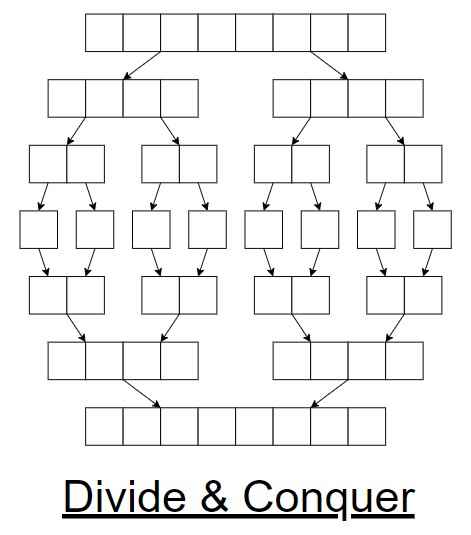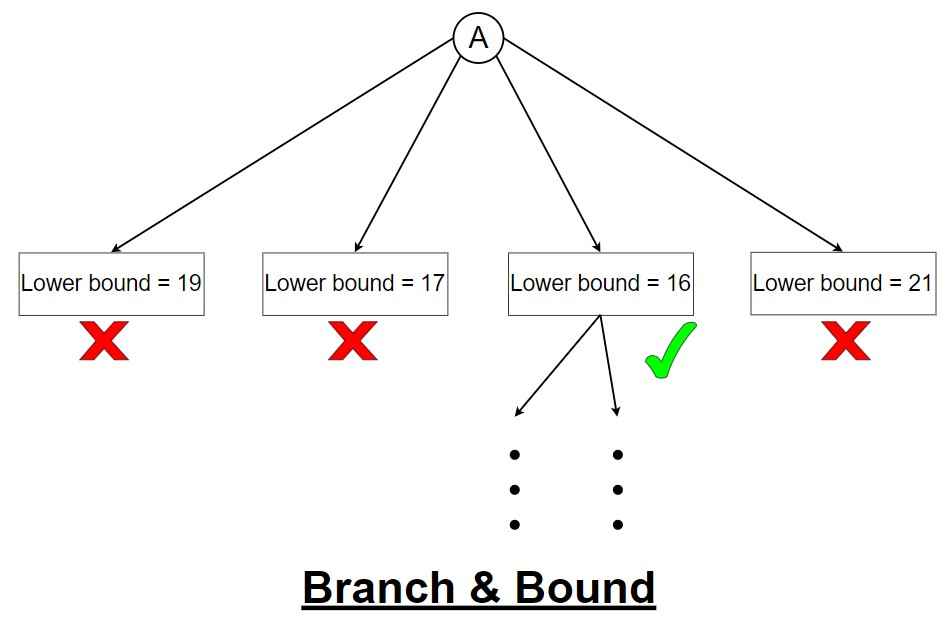Introduction
.
The Branch and Bound algorithm is a powerful technique used to solve optimization problems, especially when the solution space is large and complex.
It systematically explores all possible solutions by dividing the problem into smaller subproblems (branching) and uses bounds to eliminate subproblems that cannot lead to an optimal solution (bounding).
This approach is often applied to combinatorial problems like the Traveling Salesman Problem (TSP), knapsack problem, and integer programming.
.
History of the Branch and Bound Algorithm
The “Branch and Bound” method was formally introduced by British researchers Alisa H. Land and A. G. Doig in their 1960 paper, where they applied the technique to integer programming.
Their work laid the groundwork for the systematic exploration of solution spaces by branching into subproblems and using bounds to prune non-promising branches.
Around the same time, Richard Bellman contributed to dynamic programming, which shares some conceptual similarities with Branch and Bound. Bellman’s work on decision processes influenced the development of methods for solving optimization problems, including Branch and Bound.
Working of Branch and Bound
- Branching:
- The problem is broken down into smaller subproblems.
- Each subproblem represents a potential solution or part of a solution.
- The process of branching continues until the problem is simplified to a point where it can be easily solved.
- Bounding:
- For each subproblem, calculate an upper or lower bound on the possible solution.
- If a bound indicates that a subproblem cannot produce a better solution than the current best-known solution, that branch is pruned (discarded).
- Pruning:
- Pruning is the process of eliminating branches that cannot lead to an optimal solution.
- By pruning, the algorithm reduces the number of subproblems that need to be explored, making the search more efficient.
- Backtracking:
- After exploring one branch, the algorithm backtracks to explore other branches, ensuring that all potential solutions are considered.
- The best-known solution is updated whenever a better solution is found.
Please don’t misunderstand this problem by Divide & Conquer. There is a difference between Divide & Conquer Vs Branch & Bound.
Divide and Conquer is a strategy used in algorithm design that breaks a problem into smaller, independent subproblems, solves each subproblem recursively, and then combines their solutions to solve the original problem.

.
This approach is particularly effective when the subproblems are simpler versions of the original problem and can be solved independently.
Common examples include algorithms like Merge Sort, Quick Sort, and Binary Search, where the problem is divided into smaller parts, solved separately, and then combined to get the final solution.
Branch and Bound on the other hand, is an algorithmic method used primarily for solving optimization problems. It systematically explores the solution space by dividing it into smaller branches, and uses bounds to prune branches that cannot lead to an optimal solution.

.
The idea is to explore the most promising branches first while discarding others, making the search more efficient.
This method is especially useful for problems like the Traveling Salesman Problem and the Knapsack Problem, where the goal is to find the best possible solution among many possible options.
While Divide and Conquer is focused on dividing the problem into independent subproblems, Branch and Bound focuses on exploring a solution space and pruning unnecessary parts based on bounds. Both are powerful techniques but are applied in different contexts depending on the nature of the problem.
.
Also, there is difference between Backtracking and Branch & Bound approach.
Backtracking is an algorithmic technique used to solve problems incrementally by building a solution piece by piece. If a piece is found to lead to a solution that does not meet the criteria or constraints of the problem, the algorithm “backtracks” by removing the last piece and trying another path.
![]()
.
It means by backtracking, we solve one path and the path does not meet with the constraints of the problem then we backtrack but, in the “branch & bound” approach, we never go onto that path that doesn’t meet the constraints of the problem, and we can predict it by bounding (lower bound or upper bound).
.
Here are some classic problems that can be solved using the Branch and Bound algorithm:
1. Traveling Salesman Problem (TSP)
- Problem Statement – Given a list of cities and the distances between each pair of cities, find the shortest possible route that visits each city exactly once and returns to the origin city.
- Branching – Select the next city to visit.
- Bounding – Calculate the lower bound of the cost for a partial tour.
- Application of Branch and Bound – This problem is typically solved by exploring all possible routes and pruning those routes that exceed the current best-known solution’s cost.
2. 0/1 Knapsack Problem
- Problem Statement – Given a set of items, each with a weight and a value, determine the number of each item to include in a collection so that the total weight is less than or equal to a given limit and the total value is maximized.
- Branching – Decide whether to include an item in the knapsack.
- Bounding – Calculate the upper bound of the maximum possible value with the remaining items.
- Application of Branch and Bound – The algorithm explores combinations of items, pruning combinations that cannot yield a better solution than the current best.
3. Integer Linear Programming (ILP)
- Problem Statement – Optimize a linear objective function subject to linear equality and inequality constraints, where some or all of the variables are required to be integers.
- Branching – Split the problem into subproblems by fixing an integer variable.
- Bounding – Use the solution of the relaxed linear program (where integer constraints are removed) to obtain bounds.
- Application of Branch and Bound – This method is used to find the optimal integer solution by exploring and pruning subproblems based on bounds.
4. Job Scheduling Problem
- Problem Statement – Assign jobs to machines in a way that minimizes the maximum completion time.
- Branching – Assign jobs to different machines.
- Bounding – Calculate the minimum possible completion time for a partial schedule.
- Application of Branch and Bound – The algorithm explores different job assignments and prunes those that cannot improve the current best-known completion time.
.
Time Complexity
The time complexity of the Branch and Bound algorithm can vary depending on the specific problem and the bounding function used.
In the worst case, it can be exponential, O(bd), where b is the branching factor (the number of subproblems generated at each step) and d is the depth of the solution space (the number of decisions to reach a solution). This is because, in the worst case, the algorithm might have to explore all possible branches.
.
Space Complexity
The space complexity of Branch and Bound also depends on the specific problem but is generally O(b × d) or O(bd).
It requires space to store all the nodes in the search tree, which can be large if the branching factor or depth is significant. However, if an iterative approach or a priority queue is used, the space complexity can be reduced to a more manageable level.
.
Advantages
- It guarantees finding the optimal solution because it systematically explores the entire solution space, pruning suboptimal branches.
- It significantly reduces the number of solutions that need to be evaluated, making it more efficient than brute force methods.
- It can be applied to a wide range of combinatorial optimization problems like the Traveling Salesman Problem, Knapsack Problem, Job Scheduling, etc
- It is particularly useful for problems with specific constraints, as it effectively prunes solutions that violate these constraints.
.
Disadvantages
- The worst-case time complexity can still be exponential, making it impractical for very large problem instances.
- It can require significant memory to store nodes and paths, especially for large problems with high branching factors.
- Implementing the Branch and Bound algorithm can be complex, especially when designing effective bounding functions for pruning.
- The efficiency of Branch and Bound heavily depends on the quality of the bounding function, which may not always be favourable.
Test Yourself
Q1- How does Branch and Bound differ from Dynamic Programming in solving optimization problems?
Branch and Bound systematically explores the solution space by branching and uses bounds to prune non-promising paths, focusing on finding the optimal solution.
Dynamic Programming, on the other hand, solves problems by breaking them into overlapping subproblems, storing the solutions to subproblems to avoid redundant calculations.
While Branch and Bound may require exploring a large solution space, Dynamic Programming builds up solutions efficiently using stored results.
Q2- In what scenarios would Branch and Bound be less efficient than Backtracking?
Branch and Bound might be less efficient in problems where bounds do not effectively prune many branches, leading to an extensive search space.
In contrast, Backtracking can be more straightforward when constraints are easier to check early in the process, making it faster to eliminate non-viable solutions.
Q3- Can Branch and Bound be used to solve non-deterministic problems? Why or why not?
Branch and Bound is typically used for deterministic problems because it relies on systematic exploration and precise calculation of bounds.
Non-deterministic problems, where outcomes are uncertain, may not allow for effective bounding, making this method less suitable.
Q4- Why is the choice of a good bounding function crucial in Branch and Bound?
A good bounding function is crucial because it determines how effectively the algorithm can prune the search space. An effective bounding function significantly reduces the number of subproblems that need to be explored, improving efficiency. A poor bounding function may lead to exploring too many branches, making the algorithm inefficient.
Q5- What is the impact of the branching factor on the performance of the Branch and Bound algorithm?
The branching factor directly impacts the performance of the Branch and Bound algorithm.
A higher branching factor increases the number of subproblems generated at each step, which can lead to exponential growth in the search space, making the algorithm slower.
Conversely, a lower branching factor can reduce the number of branches, speeding up the process.
Q6- How does Branch and Bound ensure that the solution is optimal?
Branch and Bound ensures optimality by systematically exploring the entire solution space and pruning suboptimal branches based on bounds. Since it evaluates every possible solution path, either directly or indirectly, it guarantees that the best possible solution is found.
Q7- What role does the priority queue play in the Branch and Bound algorithm?
In Branch and Bound, a priority queue is often used to explore the most promising branches first.
The queue orders subproblems based on their bound values, ensuring that the algorithm focuses on the most likely candidates for the optimal solution, thereby improving efficiency.
Q8- Is it possible for Branch and Bound to revisit a previously pruned branch? Why or why not?
No, once a branch is pruned in Branch and Bound, it is not revisited. Pruning is based on the determination that the branch cannot lead to an optimal solution, so revisiting it would be inefficient and unnecessary.
Q9- How does Branch and Bound handle problems with multiple optimal solutions?
Branch and Bound can handle multiple optimal solutions by continuing to explore the solution space even after finding an optimal solution, depending on the problem and implementation. It can be modified to record all optimal solutions or stop after finding the first one, depending on the requirement.
Q10- Why might Branch and Bound be preferred over heuristic methods in some cases?
Branch and Bound might be preferred over heuristic methods because it guarantees finding the optimal solution, whereas heuristics may only provide approximate solutions.
In problems where optimality is critical, Branch and Bound’s exhaustive search and pruning make it more reliable despite its potentially higher computational cost.
Q11- What is the main goal of the Branch and Bound algorithm?
To divide the problem into smaller independent subproblems.
To explore all possible solutions and prune suboptimal ones.
To approximate a solution using heuristics.
To solve the problem using dynamic programming techniques.
Ans – (2)
Explanation – The primary goal of Branch and Bound is to explore the entire solution space while pruning branches that cannot lead to an optimal solution.
Q12- In which of the following problems is Branch and Bound commonly applied?
Binary Search
Merge Sort
Traveling Salesman Problem (TSP)
Matrix Multiplication
Ans – (3)
Explanation – Branch and Bound is often used in optimization problems like TSP, where finding the optimal solution among many possibilities is crucial.
Q13- What does “pruning” refer to in the Branch and Bound algorithm?
Dividing the problem into smaller parts.
Solving the problem using recursion.
Eliminating branches that cannot lead to an optimal solution.
Combining solutions of subproblems.
Ans – (3)
Explanation – Pruning in Branch and Bound means discarding parts of the search space that are guaranteed not to contain the optimal solution.
Q14- Which data structure is often used to implement the Branch and Bound algorithm?
Stack
Queue
Priority Queue
Linked List
Ans – (3)
Explanation – A priority queue is typically used to prioritize the exploration of the most promising branches first in Branch and Bound.
Q15- How does Branch and Bound differ from Backtracking?
Branch and Bound prunes branches based on bounds, while Backtracking does not.
Backtracking is used for deterministic problems, Branch and Bound for non-deterministic problems.
Branch and Bound is faster than Backtracking.
Backtracking guarantees optimal solutions, Branch and Bound does not.
Ans – (1)
Explanation – The key difference is that Branch and Bound uses bounds to prune the search space, whereas Backtracking does not.
Q16- What is the advantage of using Branch and Bound over brute force methods?
It always uses less memory.
It can prune suboptimal solutions
It is easier to implement.
It is faster in all cases.
Ans – (2)
Explanation – Branch and Bound is more efficient than brute force methods because it can prune parts of the solution space that are not promising, reducing the number of evaluations needed.






